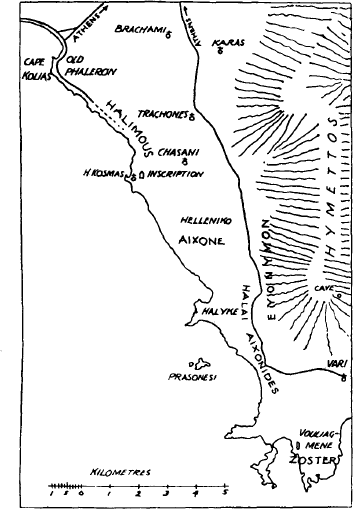Early in 1921 the Neuchâtel Asphalte Company, in beginning the construction of the new coast road from Old Phaleron to Vouliagmene(see map, Fig. 1), found not far inland from the small promontory of Hagios Kosmas some ancient foundations, and by them the inscription, which is here published. The discovery was communicated by Mr. Bottomley, Manager of the Company, to the British School, and to him I am indebted for permission to publish it, and also for the sketch plan of the ancient foundations here shown (Fig. 2). On the top of a low hill the line of a wall (about 1·50 m. thick) of the late fifth or fourth century B.C., built of rectangular blocks of poros, appeared, and on the top of this the inscription was found as indicated in the plan (Fig. 2). Slightly north of the inscription was a large block running out westwards at right angles to the main wall. If the main wall is the boundary of the Shrine of Dionysos mentioned in the inscription, it is possible that this big block formed part of the shrine itself. In any case it seems likely that we should recognise in these remains, scanty though they are, the ruins of the Dionysion in which the inscription was to be erected. On the south side of the road a double tomb came to light (Fig. 2). In the upper tomb, which was covered by a large tile so curved that it was in section half an ellipse, a small aryballos with a simple anthemion ornament in a very late red-figure style was found with a few much-decayed bones, perhaps those of a child; but in the lower tomb, which was made of two shallow rectangular troughs of terra-cotta, there were only a few bones. The tomb, which cannot be earlier than the late fifth century B.C., would not be likely to have any connection with the Dionysion, and was in any case outside it.
